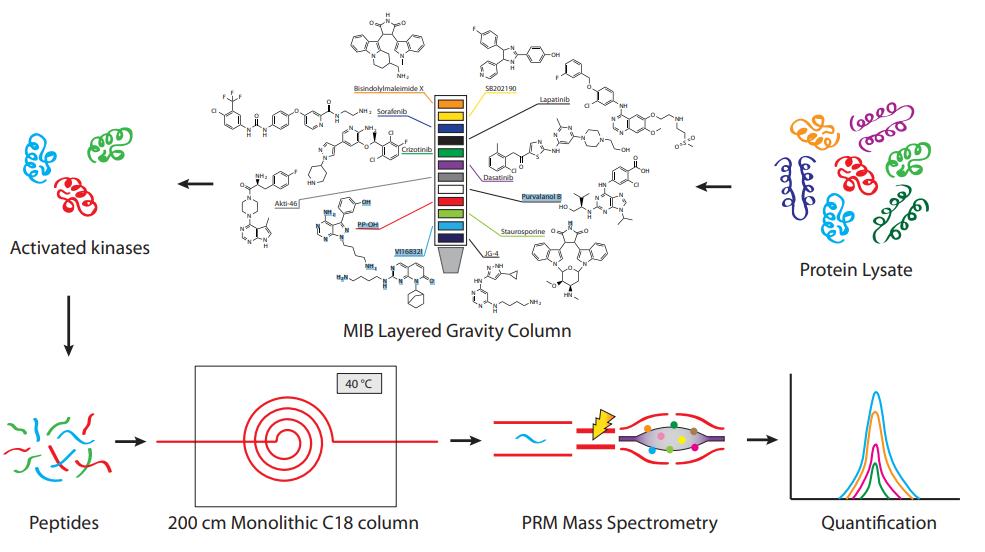4D-PRM Targeted Proteomics Analysis
Due to the large variety and quantity, protein assays generate massive amounts of data, and finding the protein to be analyzed quickly and accurately becomes critical to impact protein research. However, how to accurately locate the target protein among the huge amount of proteins? Deeply committed to the field of protein research for many years, Creative Proteomics provides 4D-PRM targeting analysis service for specific proteins, which can quickly and accurately locate and analyze specific proteins, assisting researchers to quickly penetrate into protein research.
What is 4D-PRM Targeted Proteomics
4D-PRM targeted proteomics stands as a cutting-edge method in the realm of MS-based proteomics. This innovative approach expands upon traditional 3D separation, which considers factors such as retention time, m/z, and intensity, by introducing a fourth dimension: ion mobility separation. The integration of ion mobility separation into proteomics not only accelerates scanning speed but also enhances detection sensitivity, ultimately amplifying the performance metrics of proteomics analysis. PRM technology is an ion detection technology based on high-resolution and high-precision mass spectrometry, which is capable of selectively detecting target proteins and target peptides, thus realizing the quantification.
The Principle of 4D-PRM Targeted Proteomics
Ion mobility refers to the velocity at which ions traverse a defined gaseous region under the influence of a unit electric intensity. It allows the separation of peptides co-eluting with similar m/z based on their ion shape and cross-sectional characteristics, resulting in the generation of unique MS2 data. Ion mobility exploits differences in ion flight velocity within an airflow, which is determined by the size and shape of the ions. By introducing an opposing electric field that counteracts the ions' motion, it becomes possible to capture the ions at specific locations where the two opposing forces balance. By modulating the electric field strength, ions can be selectively released in a sequential manner, enabling efficient separation. Subsequently, the ions enter the collision cell for fragmentation, and a high-resolution, high-quality precision analyzer is utilized to detect information about all fragments within the window of selected parent ions in the secondary mass spectrum. In this way, target proteins/peptides in complex samples can be analyzed accurately and specifically.

Fig. 1. Schematic of 4D-PRM
Our Service
Creative Proteomics provides high-quality 4D-PRM targeted proteomics analysis services, including but not limited to validating protein changes, quantifying protein abundance and exploring modification sites. In addition, PRM targeted proteomics analysis is also available.

Fig. 2. 4D-PRM targeted proteomics workflow (Urisman. A, et al., 2017)
Applications of 4D-PRM Targeted Proteomics
- Biomarker Analysis
4D-PRM is instrumental in the validation of potential protein biomarkers identified through various screening methods. It allows for the precise and quantitative analysis of specific proteins, confirming their relevance as biomarkers for diseases or conditions. - Post-Translational Modification Exploration
The technology is adept at in-depth exploration of PTMs to proteins. This is crucial for understanding how proteins are modified after translation, influencing their functions and cellular roles. - Drug Discovery and Development
4D-PRM has the ability to quantify the abundance or post-translational modifications of target proteins, helping to understand how potential drug candidates interact with specific proteins, and is therefore valuable in drug discovery. - Personalized Medicine
4D-PRM contributes to personalized medicine by enabling the precise quantification of proteins in individual patients. This can be crucial for tailoring treatment approaches based on the specific proteomic profile of a patient.
In addition, 4D-PRM also plays a role in protein interaction studies, food safety, and environmental testing. Overall, 4D-PRM targeted proteomics plays an important role in the dynamic field of scientific exploration, and provides important ideas for solving complex problems in the fields of biology, medicine, health, and environmental science.
Advantages of 4D-PRM Targeted Proteomics Analysis
- It provides accurate quantitative data, enabling researchers to determine the exact abundance of a target protein.
- It provides detailed information at high throughput.
- It can selectively monitor predefined peptides or proteins, making it ideal for targeted analysis.
- It is highly sensitive and can detect and quantify low concentrations of proteins even in complex samples.
If the realm of 4D-PRM targeted proteomics analysis intrigues you, we invite you to reach out for more details. Creative Proteomics is your trusted partner in navigating the complexities of proteomics research. Contact us to unlock the potential of advanced proteomics analysis services.
Reference
- Urisman A; et al. An Optimized Chromatographic Strategy for Multiplexing In Parallel Reaction Monitoring Mass Spectrometry: Insights from Quantitation of Activated Kinases. Molecular & Cellular Proteomics. 2017, 16(2): 265-77

